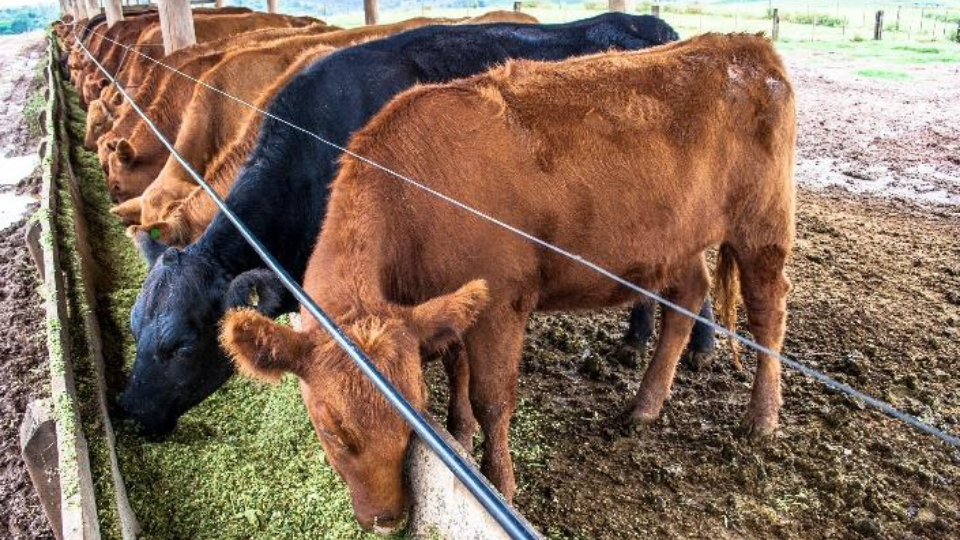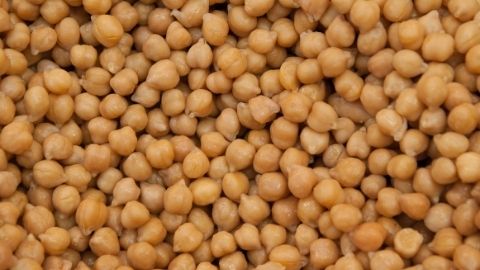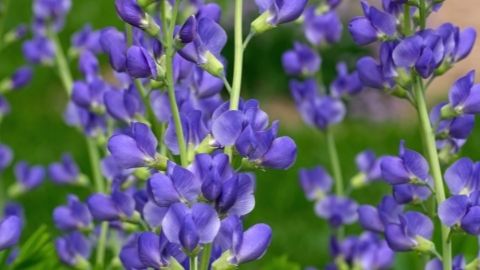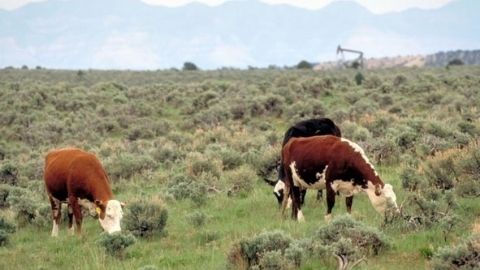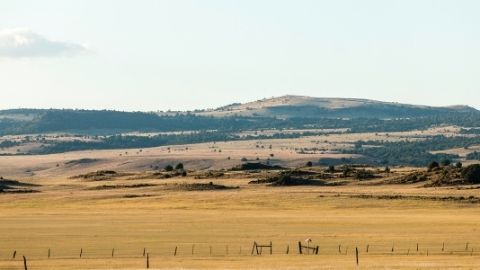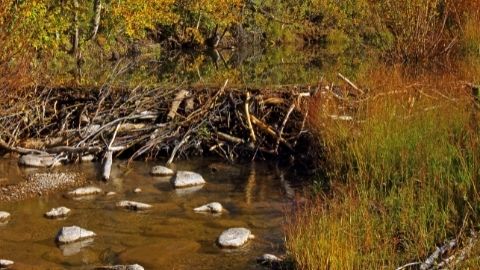Drought-Tolerant Options for Southwest Agriculture: Ornamentals, Herbs, and Cosmetics
Introduction
The arid Southwest has been heavily impacted by drought and climate change. Temperatures in the region rose 2 degrees Fahrenheit in the last century and are expected to rise from 3 to 9 degrees by the end of the century (Climate Impacts in the Southwest, 2016). The Southwest states are some of the driest in the nation. From 2000 to 2020, 65% of the state of Utah experienced abnormally dry conditions, 78% of Arizona, 69% of New Mexico, and 71% of Nevada. Water shortages are also common, especially in the late summer when water restrictions are often imposed. Drought levels of this magnitude damage pastures and crops, leading to economic losses in agriculture.
In the Southwest, American Indian farmers and ranchers provide an important economic base for rural areas. Sustaining agricultural production (crops, food, livestock) on tribal lands will become progressively more challenging in the future due to decreased water availability, extended droughts, and changes in precipitation quantities and timing. Close cultural and economic ties to natural resources, geographic remoteness, and economic challenges characterize American Indian reservations as some of the most vulnerable populations to climate change impacts (Melillo et al., 2014).
This fact sheet is the third in a series of three that provide an overview of drought-tolerant crops, grasses, and native plants, which may assist in maintaining agricultural production for food, feed, and cosmetics and sustain grasslands and rangelands in the arid Southwest. The following ornamental, herbs, and cosmetics are drought tolerant. Their drought-tolerant features are discussed in addition to soil preferences, preferred growing conditions, and market conditions and profitability.

Blossoms
Ornamentals
Spanish Lavender (Lavandula stoechas)
Spanish lavender is an ornamental but also has edible, oilseed, and medicinal properties. Spanish lavender thrives best in well-drained, low fertility soils (Ellis, 2020). It originated in the Mediterranean region of Southern Europe, Northern Africa, and surrounding islands (Ellis, 2020) and is hardy to zone 8. Lavender does not require colder temperatures to bloom and is sold in bunches or distilled for its essential oils (Figure 1).
One acre of lavender can produce about 12,000 bunches (Wallin, 2019). Florists and crafters purchase dried bunches for dried flower arrangements and use individual buds to make sachets and other products (Wallin, 2019). One acre can produce 1,000 to 1,500 pounds of buds per year (Adam, 2018). The price for buds and bunches is $6 to $10 per pound or bundle. The sale of lotions, soaps, and other lavender-scented, value-added products can result in 500% markups. Lavender oil, which can be extracted in a variety of different ways, has a wholesale value of $22.50 per pound and a retail value is $9,000 per gallon. Five to 25 pounds or .75–3 gallons can be extracted per acre (Adam, 2018).

Blue False Indigo (Baptisia australis)
Blue false indigo is native to North America and grows wild in the southern United States (Figure 2). It provides medicinal benefits in addition to its ornamental qualities and can be used as a weak dye (Staff, 2013). It tolerates poor-quality soil and requires a pH level of 5.5–7.0. American Indians used false indigo roots to brew a tea to stop vomiting (UIC Heritage Garden, n.d.). As a poultice, it is anti-inflammatory and can help treat toothaches. It is toxic, which is important to note; however, no human deaths have been attributed to its use (Staff, 2013).
Blue false indigo seeds germinate rapidly, but it takes three to four years for the plants to develop flowers (Staff, 2013). The plants grow 3–4 feet in height and width, and harvested stalks are dried upside down for use in wreaths and floral arrangements. Seedpods are used to create a light blue dye. False indigo can be sold directly to florists or to consumers. Prices vary by season, location, and retailer. The price per 10 stems ranges from $6– $18 per bundle (Scoggins, 2019).
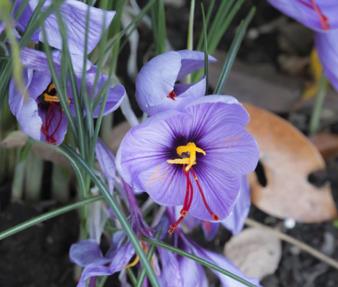
Saffron (Crocus sativus)
The brightly colored red stamen in the center of crocus flowers is a high-value spice known as saffron (Figure 3). Plants take approximately eight weeks to reach maturity when planted in mid to late summer and are harvested in October through November. Flowers bloom in the fall and each bloom yields up to three harvestable stigmas (Barth, 2017). Harvesting is labor-intensive, which is why saffron is referred to as “red gold” (The Cultivation of Saffron, n.d.). The crop originates in the Middle East and southeast Asia but is now grown worldwide. Saffron does not grow well where temperatures are below –4 or above 104 degrees Fahrenheit. Irrigation is critical in the spring, but hot and dry summers do not inhibit growth. Saffron prefers a soil pH of 6–8 (The Cultivation of Saffron, n.d.).
Saffron is one of the highest-priced spices in the world, selling at $3,000–$9,000 per pound (Skinner et al., 2016). This crop is financially lucrative on a small scale, although it is extremely labor-intensive. The stigmas from each flower are removed by hand, and approximately 50,000 flowers are needed to produce one pound of dried saffron. One acre yields 200,000 flowers (Barth, 2017), and thus, one acre can return $12,000–$36,000 of revenue. The crop is purchased by spice companies for commercial sale through retail and to restaurants.
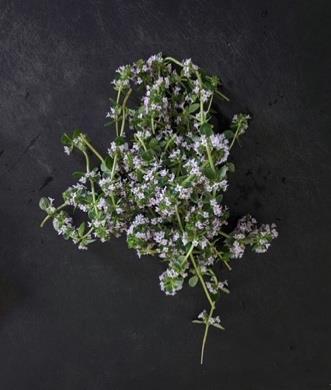
Herbs
Thyme (Thymus officinalis)
Thyme is not native to America but is well established in the U.S. (Figure 4). Thyme is a woody perennial shrub that lives for approximately five years before it must be replaced. It is an evergreen in zones 6–8 but can be grown successfully from zone 4 (SimplyHerbs, n.d.). Commonly known for its culinary use, thyme takes 90 days to reach maturity, grows best at soil pH of 4–8, and likes hot, sunny environments with welldrained soils (Hoyer, 2004).
Thyme can be distilled to an oil (thymol) that is used as an antiseptic or incorporated into mouthwashes (Dunn, 2013). One acre yields 1500 pounds of dried thyme or 20 pounds of essential oil (SimplyHerbs, n.d.). Thyme is sold to wholesalers who package and distribute the herb, with current wholesale prices of $9.25 per pound (Price Charts, 2020).
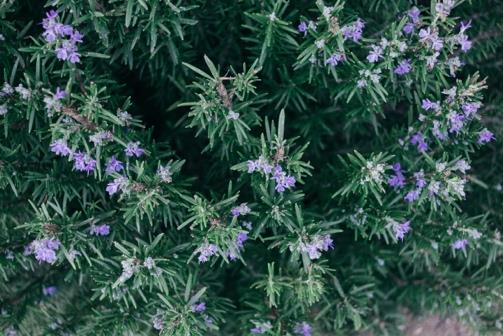
Rosemary (Rosmarinus officinalis)
Originating in the Mediterranean region and the Middle East (de Oliveira, et al., 2019), it takes 42 days for rosemary to reach maturity after transplanting (How to Grow Rosemary, n.d.). In addition to its culinary properties, rosemary has many medical properties including antiinflammatory, antioxidant, antimicrobial, and antitumor and protective effects (de Oliveira, et al., 2019). Rosemary is an evergreen shrub that prefers low fertility, slightly acidic (pH 6.0–7.5), and sandy soils (Figure 5). It tolerates some shade but prefers full sun (Gitau, 2011).
Rosemary is not native to the U.S. but arrived with early European settlers. One acre can yield up to one ton of dried rosemary. Like thyme, rosemary is sold to wholesalers at an average price per pound of $13, but prices vary based on season, location, and quality (Price Time Series, 2020).
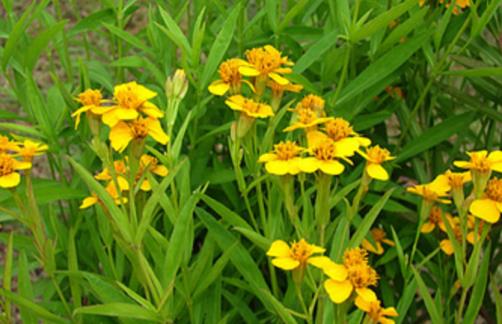
Blossoms
Mexican Tarragon (Tagetes lucida)
Tarragon is an edible ornamental that takes 85–90 days to reach maturity (Figure 6). Not to be confused with French tarragon, this herb endures the heat much better (Mexican Tarragon, 2016). Tarragon prefers full sun, tolerates drought well, and requires low fertility soils with a pH of 6.5–7.0 (Growing Tarragon, 2021). It requires some irrigation for optimal production, and drip irrigation is recommended (Dyer, 2018).
Grown as an annual in cooler regions, Mexican tarragon is a perennial in warm regions, growing best in zones 9–11 (Dyer, 2018). The plant was used by the Aztecs in their cocoa beverages and is still used to make herbal teas (Mexican Tarragon, 2016). Tarragon can be sold dried for approximately $5.50 per pound (Miller, 2013). The price is wholesale to spice companies who then process and package it for retail sales.
Cosmetics

Jojoba (Simmondsia chinensis)
Jojoba is not very well known, but grows wild in southern California, Arizona, and sections of Mexico (Spengler, 2018). It is extremely drought tolerant, requiring roughly three inches of irrigation per year (Jojoba, n.d.). Native Americans used jojoba for the oil seeds produced (Figure 7). The oil is added to hair care products and medicine, while the ground seeds are used to make tea (Spengler, 2018). The oil is used in the cosmetic industry as a lubricating agent in moisturizers, lipsticks, and shampoos (Jojoba, n.d.).
Jojoba grows best in sandy, low fertility soils. Male plants are required to fertilize female plants, which start producing seeds five years after establishment. Plants reach their full production potential around years 8–10 (Jojoba, n.d.). Jojoba is an extremely low maintenance crop, requiring very little irrigation and no additional fertilizers. One acre yields about 3,000 pounds of seed, and seeds have an oil content of 52%. When purchased by commercial cosmetic producers, prices vary from $2 to $10 per pound of oil.
Conclusions
The drought-tolerant ornamentals, herbs, and cosmetics discussed here are options for maintaining agricultural production as climate change impacts the arid Southwest. While many of those discussed are native to the U.S. and used in Native American culture, others originated in other drought-prone areas of the world. The plants and herbs discussed here are not an exhaustive list, and other options may be equally useful or profitable. University Cooperative Extension and United States Department of Agriculture (USDA) publications regarding plant propagation, growing, harvesting, and marketing should be consulted when deciding on the best option for a specific area or region.
Picture Credits
- Figure 1. Meuche, J. (2020). Unsplash. https://unsplash.com/s/photos/spanish-lavender
- Figure 2. mckaynursery.com
- Figure 3. Lamonica, L. (2019). Saffron in Japan. Unsplash. https://unsplash.com/s/photos/saffron-crocus
- Figure 4. Sigmund. (2020). Unsplash. https://unsplash.com/s/photos/thyme
- Figure 5. Hanaoka, P. (2018). Unsplash. https://unsplash.com/s/photos/rosemary
- Figure 6. Mexican Tarragon. (n.d.). Crimson Sage Medicinal Plants Nursery. https://www.crimsonsage.com/store/native-american-herbs/mexicantarragon192-detail
- Figure 7. Shebs, S. (2019, April 15). Jojoba. Encyclopedia Britannica. https://www.britannica.com/plant/jojoba
References
- Adam, K.L. (2018, October). Lavender production, markets, and agritourism. ATTRA Sustainable Agriculture, National Center for Appropriate Technology. Retrieved May 15, 2020, from https://attra.ncat.org/product/lavender-production-marketing-and-agritourism/.
- Barth, B. (2017, July 17). 5 of the most valuable crops you can grow in the U.S. & how to grow them. Modern Farmer. Retrieved February 21, 2020, from https://modernfarmer.com/2017/07/5-valuable-crops-can-growus-grow/
- Climate Impacts in the Southwest. (2016, December 22). U.S. Environmental Protection Agency (EPA). Retrieved February 19, 2020, from https://19january2017snapshot.epa.gov/climate-impacts/climate-impactssouthwest_.html
- de Oliveira, J.R., Camargo, S.E.A. & de Oliveira, L.D. (2019, January 9). Rosmarinus officinalis L. (rosemary) as therapeutic and prophylactic agent. Journal of Biomedical Science 26(5). https://doi.org/10.1186/s12929- 019-0499-8
- Dunn, B. (2013, May 10). A brief history of thyme. Food, A&E Television Networks. Retrieved February 19, 2020, from https://www.history.com/news/a-brief-history-of-thyme
- Dyer, M.H. (2018, April 4). What Is Mexican tarragon: How to grow Mexican tarragon herb plants. Gardening Know How. Retrieved February 19, 2020, from https://www.gardeningknowhow.com/edible/herbs/mexicantarragon/mexican-tarragon-herb-plants.htm
- Ellis, M.E. (2020, February 8). Spanish lavender plants: How to grow Spanish lavender in the garden. Gardening Know How. Retrieved February 19, 2020, from https://www.gardeningknowhow.com/edible/herbs/lavender/spanish-lavender-plants.htm
- Gitau, M. (2011). Rosemary (Rosmarinus officinalis) agribusiness. Agro Environment Initiative. Retrieved February 21, 2020, from http://yagrein.blogspot.com/2015/12/rosemary-rosmarinus-officinalis.html
- Growing Tarragon. (2021). Bonnie Plants. Retrieved February 19, 2020, from https://bonnieplants.com/how-togrow/growing-mexican-tarragon/
- Hoyer, J. (2004). Growing and using Thyme. Retrieved February 19, 2020, https://hortnews.extension.iastate.edu/2004/8-13-2004/thyme.html
- How to Grow Rosemary. (n.d.). Herbgardening.com. Retrieved February 19, 2020, from http://herbgardening.com/growingrosemary.htm
- Jojoba. (n.d.). Oil Seed Crops. Retrieved February 21, 2020, from http://www.oilseedcrops.org/jojoba/
- Melillo, J.M., Richmond, T.C., & Yohe, G., Eds. (2014) Climate Change Impacts in the United States: The Third National Climate Assessment. U.S. Global Change Research Program. doi:10.7930/J0Z31WJ2.
- Mexican Tarragon. (2016, November 10). IFAS Gardening Solutions, University of Florida. https://gardeningsolutions.ifas.ufl.edu/plants/edibles/vegetables/mexican-tarragon.html
- Miller, R. A. (2003, May 12). Economic outlooks for herbs and spices [Unpublished manuscript]. http://www.nwbotanicals.org/oak/altagri/cropoutlook.htm
- Price Charts. (2020, May). Tridge. Retrieved May 14, 2020, from https://www.tridge.com/prices/chart?productPrices=62&productCountryPrices=1380,1757,2068,2377,3798 &items=100447,116980,56086,167266,134795&entries=40917873,40961429,40958552,40885605,4096463 5&from=2019-05-14&to=2020-05-14&period=m
- Price Time Series. (2020, May). Tridge. Retrieved May 14, 2020, from https://www.tridge.com/prices/timeseries?product=14266&from=2019-05-14&to=2020-05-14&period=m
- Rosmarinus officinalis (Rosemary). (n.d.). Gardenia. Retrieved February 19, 2020, from https://www.gardenia.net/plant/rosmarinus-officinalis-rosemary
- Scoggins, H. (2019, March 6). Marketing specialty cut flowers. Foodsystems, Extension Foundation. Retrieved May 14, 2020, from https://foodsystems.extension.org/marketing-specialty-cut-flowers/
- SimplyHerbs™ Thyme Seeds. (n.d.). Park Seed. Retrieved February 19, 2020, from https://parkseed.com/simplyherbs-thyme-seeds/p/52713-PK-P1/
- Skinner, M., Parker, B.L., & Ghalehgolabbehbahani, A. (2016, November 7). Saffron: A golden opportunity for crop diversification. Entomology Research Center, University of Vermont. Retrieved February 21, 2020, from https://www.uvm.edu/~saffron/Resources/Presentations/SaffronGoldOppNov72016.pdf
- Spengler, T. (2018, April 4). Jojoba plant care: Tips for growing jojoba plants. Gardening Know How. Retrieved February 19, 2020, from https://www.gardeningknowhow.com/ornamental/shrubs/jojoba/growing-jojoba-plants.htm
- Staff, Lady Bird Johnson Wildflower Center. (2013, October 24). Plant database, baptisia australis. University of Texas at Austin. Retrieved February 19, 2020, from https://www.wildflower.org/plants/result.php?id_plant=BAAU
- The Cultivation of Saffron. (n.d.). Sativus.com. Retrieved February 19, 2020, from https://www.sativus.com/en/saffron/the-saffron-cultivation/
- UIC Heritage Garden. (n.d.). False indigo (baptisia australis). Centers for Cultural Understanding and Social Change. Retrieved May 8, 2020, from http://heritagegarden.uic.edu/false-indigo
- Wallin, C. (2019, October 8). Top 10 FAQs about growing lavender for profit. Profitable Plants Digest. Retrieved February 21, 2020, from https://www.profitableplantsdigest.com/top-10-faqs-about-growinglavender-for-profit/
Authors
Emily Rice, Extension Intern, Department of Applied Economics; Kynda Curtis, Professor and Extension Specialist, Department of Applied Economics
Related Research


 Utah 4-H & Youth
Utah 4-H & Youth
